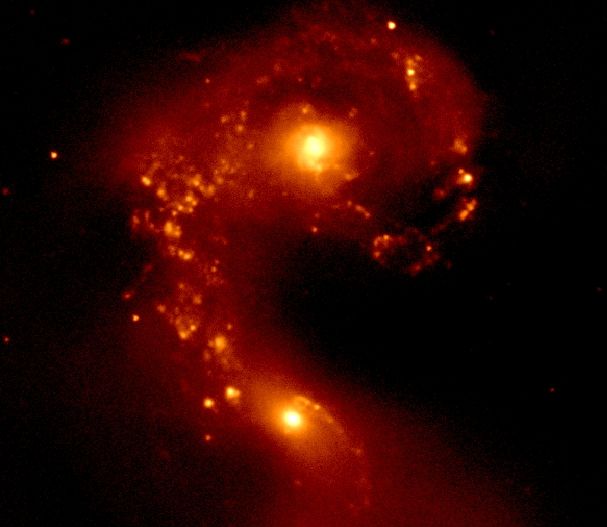
|
Explanation: What happens when galaxies collide? One of the best studied examples of the jumble of star clusters, gas, and dust clouds produced by such a cosmic train wreck is the interacting galaxy pair NGC 4038 / NGC 4039, the Antennae Galaxies, only sixty million light-years away. In visible light images, long, luminous tendrils of material seem to reach out from the galactic wreckage, lending the entwined pair an insect-like appearance. But this penetrating view from the new Wide-field InfraRed Camera (WIRC) attached to the Palomar Observatory's 200 inch Hale telescope shows, in false-color, details of some otherwise hidden features. The large central nuclei of the two original galaxies dominate the near-infrared scene speckled with other bright sources which are themselves giant, newly formed star clusters. Remarkably the northern (topmost) nucleus, obscured in optical images, is also revealed here to have a barred, mini-spiral structure reminiscent of many "single" spiral galaxies.
|
January February March April May June July August September October November December |
| ||||||||||||||||||||||||||||||||||||||||||||||||
NASA Web Site Statements, Warnings, and Disclaimers
NASA Official: Jay Norris. Specific rights apply.
A service of: LHEA at NASA / GSFC
& Michigan Tech. U.
Based on Astronomy Picture
Of the Day
Publications with keywords: NGC 4038 - NGC 4039 - interacting galaxies
Publications with words: NGC 4038 - NGC 4039 - interacting galaxies
See also:
- APOD: 2025 August 19 Á Giant Galaxies in Pavo
- APOD: 2025 June 1 Á UGC 1810: Wildly Interacting Galaxy from Hubble
- APOD: 2025 March 12 Á NGC 772: The Fiddlehead Galaxy
- Peculiar Galaxies of Arp 273
- APOD: 2025 January 6 Á Colliding Spiral Galaxies from Webb and Hubble
- Shell Galaxies in Pisces
- APOD: 2024 July 15 Á The Tadpole Galaxy from Hubble
